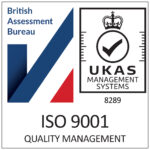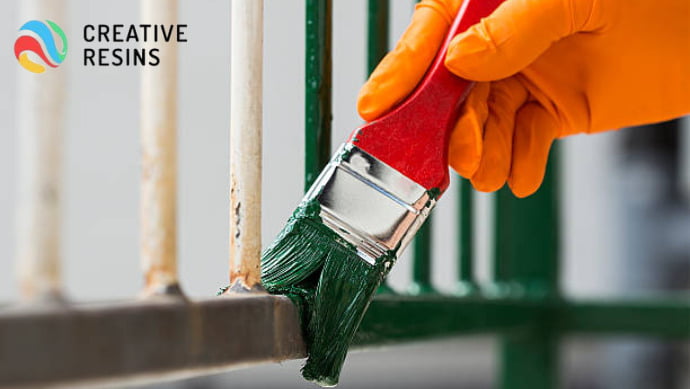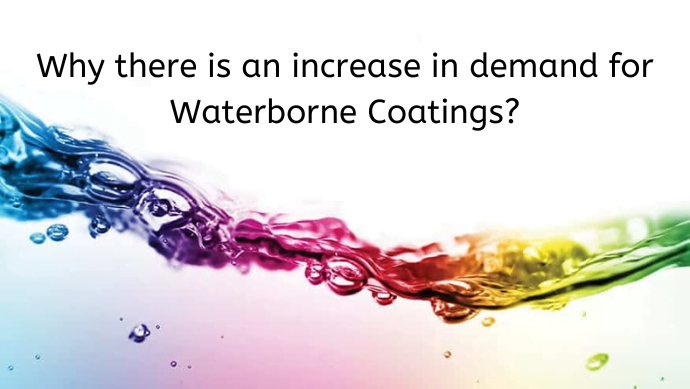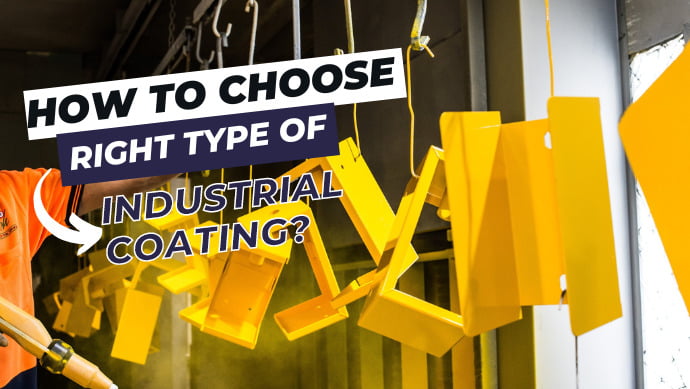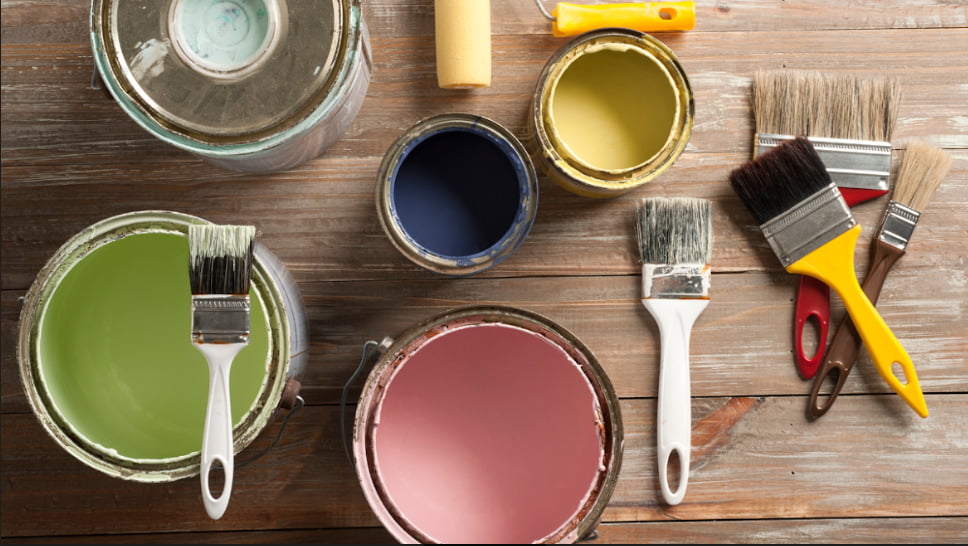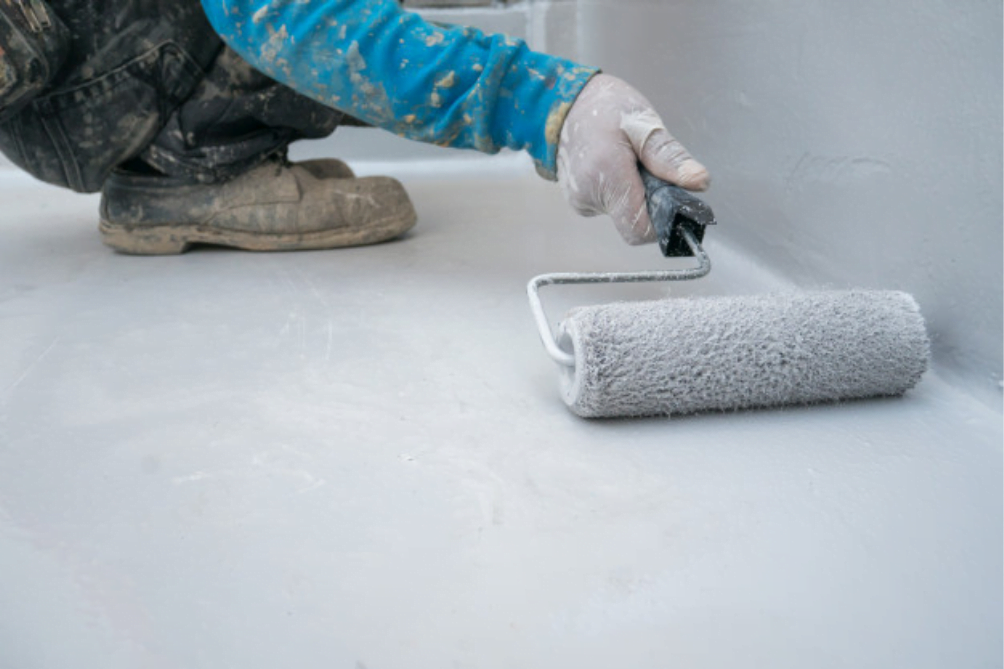Category: Surface Coating
7 Easy steps to paint metal surfaces
Applying a coat of paint is a quick and easy method to extend the life of metal surfaces. However, painting metal surfaces require a specific technique and most importantly the correct choice of paint, Doing so will help to extend the life of the metal surface and ensure that it is protected and looks at its best for many years.
Follow this guide to painting metal surfaces the right way.
Preparation for painting metal surfaces
Refurbishing your home’s metal surfaces is much cheaper than replacing them, The cost of new Metal gates and fences, steel windows, etc might make you want to dip your paintbrush in, but you must be prepared to do a good job. Here are some tips for preparing the metal surface.
Choose the suitable primer.
Choosing a primer can be challenging. You have to consider the surface condition of your metal as well as the type of metal you intend to paint. Some surfaces are in good condition and only require one primer coat, while others require two coats. Some can be painted using direct-to-metal paints that offer a primer and top coat combined within the same product. Always choose a corrosion-resistant base to protect the metal from rusting. Metal Primers are normally available in either a spray application or can be applied using a brush or roller.
Choosing the right tools
Knowing which tool to use will make the painting successful. Brushes and rollers differ in application compared to spray paint.
Paint Spray: Avoid brushstrokes with lots of nooks and crannies on irregularly shaped objects. This method is the quickest and fastest drying option. Spray paint creates a thinner layer so two or three coats may be required.
Brush or Roller: Although this method takes longer to apply, the brush or roller technique applies a thicker layer to outdoor items that need more protection from wind, sun, and rain. Painting with a brush and roller provides a more controlled application indoors or outdoors.
Safety precautions
Safety is at the forefront of any project you work on, and metal painting is no exception. Working with corroded metal poses potential health risks. When removing rust from old metal, working in a ventilated environment is essential. You must wear gloves, eye protection, and a face mask to prevent injury or illness.
1. Removing rust and old paint
Rust and old paint can prevent new paint from adhering correctly to the metal surface, causing the paint to peel off prematurely. To prevent this, you need to remove it before painting. Depending on the amount of rust, you may need one or more rust removal tools.
- Wire brush for daily surface rust
- Wire brush drill attachment for large areas with lump rust
- Soak in liquid rust remover to remove even the toughest rust stains
2. Clean the metal
After removing rust and peeling paint, clean the surface with mineral spirits, a petroleum distillate commonly utilized as a paint thinner. Brushing the metal with mineral spirits instead of water will prepare the new paint to adhere to the metal surface. Avoid using water to clean metal as it will cause more corrosion over time.
3. Sanding metal
Like a blank canvas, painting metal projects works great with small etchings on the surface to hold the paint and primer in place. To do this, you must sand the entire metal surface with a scuffing pad or fine-grit sandpaper.
4. Apply primer
With your surface ready to paint, it’s time to apply a primer to the metal. For Steel, Galvanised steel, and even aluminium you may need to apply a layer of zinc chromate primer or Red Oxide primer first to prevent further deterioration. Use a sprayer for metal surfaces with multiple cracks, and use a brush or roller if you apply a traditional primer. Apply two coats and permit the primer to dry according to the manufacturer’s instructions.
5. Metal coating
After the primer is completely dry, apply a quality topcoat of your chosen colour to the newly primed metal using a brush, roller, or paint sprayer. Allow the coat to dry completely and apply another coat if you are using a brush or roller. Repeat the process and complete three thin coats if you are using a paint sprayer.
6. Paint treatment
Although paints like acrylic dry relatively quickly, you may want to wait a day or two for the surface to fully cure.
7. Complete with TopCoat
To avoid chipping, rusting, or fading make sure that the topcoat application is thick enough. Be sure to choose a topcoat that is formulated for metal and that is also designed to withstand the elements. You can apply topcoats with a sprayer, roller, or paintbrush.
Who provides the best paints for metal surfaces?
We, Creative Resins, provide high-quality paints for metal surfaces at the most competitive prices. Give us a call today to learn more about our products and services.
Rising Demand for Waterborne Coatings
Waterborne coatings use water as a solvent to disperse the resin, making the coating environmentally friendly and easy to apply. In most cases, waterborne coatings contain up to 80% water in other solvents, such as glycol ethers. These coatings are environmentally friendly because regulations require waterborne coatings to contain less than 3.5 pounds of VOCs per gallon of water.
Reasons for the increase in demand for waterborne coatings
1. Cleaner for the environment
Waterborne coatings are a common source of non-toxic atmosphere. Waterborne epoxy coatings are a non-flammable, non-toxic, non-hazardous way to paint your equipment. These are the ideal choice when looking for a paint finish that is 100% clean air compliant.
2. Clean air for employees
In addition to cleaner waterborne coatings for the environment, they are also healthier for a person’s lungs. Reducing VOCs in waterborne paint improves workplace air quality, thus preventing you from inhaling fewer paint toxins.
3. High gloss finish
The coating itself provides a high gloss finish and also acts as an excellent anti-corrosion protector.
4. Durable and long-lasting
Waterborne coatings are more durable and abrasion resistant. Also, they can withstand heat well and can prevent corrosion. When working in harsh working environments, using water-based paint maintains its glossy appearance and protects your equipment for longer.
Water-based paint uses water as a liquefaction agent instead of chemical solvents, emitting fewer VOCs. The use of water-based paints brings benefits beyond compliance:
- It has less odor, making it safer and more convenient to operate.
- It is less flammable when working in confined spaces.
- You’re unlikely to exceed VOC limits and face hefty fines.
- It is not a hazardous waste product, so your disposal fees will be reduced.
When you are looking to repaint your construction or farm equipment, you may want to consider using waterborne epoxy paint. This paint finish leaves a beautiful, durable, high-gloss finish that lasts longer than other types of paint finishes.
The market trend of waterborne coatings
The waterborne coatings demand is an exciting and growing technological segment in the global coatings market. Waterborne coatings find their way into a variety of end-use sectors. Given the growing interest in sustainability, waterborne coatings will likely witness continued growth, and the market will continue to grow.
The total global waterborne coatings market represents 51% of the value and 57% of the size of the global coatings market. However, most of the waterborne coatings market is in the decorative coatings segment, and 90% of the worldwide market is waterborne. In the non-decorative coatings sector, the total demand for waterborne coatings represents about 10% of the value and 13% of the market size of non-decorative paints.
Segments and chemistry
Waterborne coatings find themselves in different market segments. As mentioned above, decorative coatings are the primary segment of the waterborne coatings market. They account for about 86% of the total waterborne coatings market value. Waterborne decorative coatings consist of acrylic and vinyl-based resins.
In the non-decorative coatings sector, the above chemicals, such as polyurethane dispersants (PUDs), are increasingly being applied in the coating market. In the non-decorative coatings market, the general industrial (GI), wood, and automotive sectors are the most significant market segments.
In the future, we expect aqueous products to grow slightly faster than the coatings market as a whole. As regulations tighten, there will be more switching to water products. Regulations relating to the VOC content of the coatings used. Also, in industrial zones, permits for VOCs that industrial customers can emit at their plants are becoming tighter-This is forcing some consumers to switch to water-based coatings.
Where to get the best waterborne coatings?
Creative Resins offer the best waterborne coatings at affordable prices. Call us today!
Selecting the Best Industrial Coating
Industrial coatings are applied to protect a substrate or enhance specific characteristics. Coatings can be used, among other things, to improve conductivity, toughness, or flame resistance.
Industrial coatings are often applied by using a paint, with a priming coat, a secondary coat, and a sealer or top lacquer. The most common industrial substrates are steel, aluminum, concrete, wood, plastic, and composite. Different coating types and application techniques are available, and they may be tailored to fit specific chemistries and application situations. There are industrial coatings everywhere. They can give the coated surface or product a decorative and colorful appearance while protecting it from oxidization, weathering, UV damage as well as wear and tear.
Applications for OEMs include
- Building and construction materials such as doors and windows
- Steel and metal structures
- Glass
- Machinery and appliances
- agricultural and construction equipment
- Sports and play equipment
- Safety equipment
Good quality industrial coatings help to extend the life and improve the appearance of manufactured goods. There is a broad range of potential coated surfaces, which include plastics, metals, wood, and composite materials like glass, rubber, leather etc.
A protective industrial coating may be applied to almost any substance to formulate OEM products.
Manufacturers often put industrial coating in the last phases of production. Their priceless OEM product is strengthened and protected while utilizing the specially designed coating compound during the finishing procedure.
Industrial coatings come in a wide variety of qualities. You and your formulator will collaborate to produce the desired outcome and performance. Additionally, it’s critical to create an outcome that the technicians can employ in your operation’s application procedure.
A concise summary of some higher-performance polymer types that are frequently utilized in OEM industrial coatings has been put up by us. If necessary, these polymers can be created using contemporary, waterborne or low-solvent methods.
Here, we outline some advantages that each application offers:
Polyurethane Coatings
Polyurethane coatings are used by manufacturers in various settings, frequently as a preventative and decorative finishing layer on top of other specially designed industrial primers. These coatings can increase durability and endure abuse and wear and tear by resisting abrasion as we as extreme weathering.
If desired, these coatings can have a lovely, high-shine finish while still maintaining color. Specialised combination coatings of polyurethane and acrylic offer excellent resistant to UV rays and extreme elements. For outdoor applications, these finishes are a suitable option.
Epoxy Coatings
Epoxy coatings typically combine an epoxy polymer and an amine curative agent. Consider the epoxy glue double-tubes you may employ to create a tangible link between the two materials. Formulators can change epoxies’ mix proportions (and components) to produce a broad range of properties. Users now have access to a distinctive coating to satisfy the requirements of various settings.
These coatings adhere firmly to a variety of surfaces. Epoxies provide excellent abrasion and erosion resistance. Furthermore, epoxy coatings can endure greater temperatures compared to most other coating substances.
Epoxy resins, when correctly made, can withstand heat up to several 100 degrees Fahrenheit.
Epoxies are frequently used in two-or three-layer applications. For optimal corrosion protection, a user may choose a zinc primer as the base layer. Over this primer, epoxy is added. A manufacturer may specify a polyurethane topcoat in a three-portion system that consists of an epoxy binder, a zinc base, and a finishing coat for better appearance and functioning.
Alkyd Coatings
These coatings are reliable, industrial, and OEP manufacturer coatings. Alkyd coatings are resistant to environmental influences when applied on prepared substrates. They can be specially manufactured to work well in indoor, outdoor, submerged, and subterranean locations.
To accommodate a range of circumstances, formulators modify the ingredients used to make bespoke alkyd coatings. Since alkyd coatings need to be oxygen permeable, they could dry for long hours compared to other coatings. As a result, heat is frequently used to quicken the chemical curative process.
Coatings Rich in Zinc
Zinc dust is a pigment used in these well-functioning polymers to prevent corrosion and rust. Since high-quality pigments warrant high-performance polymers, epoxy or polyurethane resin binders are frequently used to create organic zinc coatings.
When applied to steel, zinc coatings are very efficient in preventing corrosion because they act as a polymeric and galvanic barrier. Zinc-rich coatings are tough and abrasion-resistant.
Acrylic coatings
The short drying time and high shine capacity of acrylic coatings are only two of their numerous benefits. They work well as primers to encourage adhesion. Acrylics frequently need fewer chemicals and may improve the corrosion resistance of the coated product.
Obtain the industrial coating you require
Because of the wide variety of industrial coatings available in the market, Creative Resins can develop an industrial coating that perfectly satisfies your OEM specifications. The industrial coating formulas we create at Creative Resins are made specifically for your base, final use, and application requirements.
Water vs. Solvent-Based Coatings: Differences
This post is for you if you are wondering about the difference between water-based and solvent-based coatings. Coatings often obtain their name from the resin or binder from which they are made. Examples of resins that give the name of the coatings include epoxies, alkyds, and urethanes. The coatings are made up of these elements only. Additionally, coatings may contain additives with specific properties and pigments that impart color. They may also include a component that helps the coating dissolve in liquid, making it easier to apply.
Typically, a chemical solvent or water is used as a liquefaction agent. The terms “solvent-based” and “water-based” are derived from the agent type used. The right product for the job depends on the situation in which it is used. Usually, one is not better than the other, but they work very differently depending on their situation. You can get both types of coatings available in Creative Resins.
Water-based coatings
About 80% of paints sold today are water-based paints. This is undoubtedly due to the appeal of water-based products; whether heavy-duty protective coatings or interior paint for the home, it has low odors.
When you work in poorly ventilated or confined places, solvent evaporation can cause discomfort and pose a health hazard for anyone. For this reason, many projects have railroad cars and fuel storage tanks and use water-based coatings. This decreases the concentration of combustible vapors and components that often accumulate in confined areas. However, Occupational Safety and Health Administration-approved confined space safety regulations will still be in effect.
Compliance with ecological zones is a fundamental reason for choosing water-based paint. With time, most solvents evaporate into volatile organic compounds (VOCs). State, national and provincial governments regulate VOCs by controlling how much organizations can emit during specific periods. The Environmental Protection Agency sets national regulations for the VOCs, but some states have stricter restrictions that specify the need to reduce emissions.
Water-based paints contain virtually 0% solvents. Many coatings will contain co-solvents, which are just solvents in lesser concentrations and act to push water out of the coating during the drying process. Water-based paint has little or no solvents, so it’s a great way to reduce the VOC output. For some companies, this may mean lowering expenditure on environmental compliance advising or keeping them from paying huge fines that exceed the VOC quota set for that sector.
Solvent-based coatings
These special coatings contain liquefying components that evaporate by chemical reaction with oxygen. Typically, circulating air around solvent-based coatings speeds up the reaction, thus reducing the drying time.
These special coatings have a considerable advantage over water-based paints. These paints can tolerate various environmental conditions, such as humidity and temperature, during processing. Moisture in the air can inhibit the water from evaporating in water-based coatings, making them inappropriate to use in specific areas.
Water-based paints also present a challenge for surface preparation during any painting project. Although water is an excellent alternative to harsh solvents in certain circumstances, it is still a significant factor in corrosion. Therefore this is the primary purpose for using industrial coatings to protect surfaces from corrosion, wear, and other damage. If water comes in contact with the substrate before the coating is applied, rusting may occur in that spot. Water-based coatings must be formulated to remove all water from the surface film before corrosion occurs to ensure this does not happen. On the other hand, this process is not considered for solvent-based paints.
To sum up, water-based coatings have both strengths and weaknesses. They are an excellent choice for activities in confined spaces and continuous coating applications, but they may not be as durable as other coatings. Jobs in wet, exposed conditions such as those in recoating projects may still benefit from the correct coating type. If you want to find the best product for your project, Creative Resins would be happy to help with more information.
You can explore our products here.
Special Effects Paint for Unique Surfaces
Sometimes you want your painted surfaces to possess more than a clean finish with plain colours. It is fascinating to have your personality or mood be reflected on walls, doors, and windows of your humble abode. Fortunately, it is extremely simple to make these surfaces not only stand out but also make them appear alive with a diverse range of special effect paint products.
These unique paint solutions can considerably transform and enhance any ambiance from bland to something really special. There are a wide variety of paint effect techniques available out there that can be used to achieve visually spectacular results. Most of them you can find right here at Creative Resins’ massive online store for paint related accessories and goods.
So without much further ado, let’s look at a small selection of the different types of special effect paint solutions you can grab at unparalleled prices from Creative Resins’ online store.
1 – Special Effect – Pearlescent
If you want to give your glass, windows, or door surfaces the look and appeal of a shimmering pearl, then this special effect solution is ideal for you. This easily sprayed solution gives the surface of a glass an exclusive depth of character. GlassPaints Pearlescent can be applied onto any type of glass surface to creating a range of stunning effects.
Pearlescent can be applied on its own to create a translucent effect allowing light to pass through it causing the pearls to dance. Alternatively it can be backed by any solid colour… creating a wealth of different finishes to suit any interior colour scheme. Pearlescent is ideal for splash-backs or shower enclosures and exhibits excellent heat resistant and waterproof properties.
Creative Resins’ special effect – crackle paint can be applied to create a unique crackle effect on splashbacks. This crackle paint won’t scratch, fade or delaminate. This is a pre-mixed ready-to-use paint that is easily applied using a conventional spray gun. Crackle produces a unique system where the base coat fractures in an irregular fashion leaving a transparent vein. A coloured topcoat or mirror coat can also be added that fills the clear areas to create attractive and unusual effects.
Creative Resins’ special effect Glitter solution can be applied to give a unique appeal to glass windows and skylights. This special item is available in a variety of colours to provide some interesting and bespoke special effects to glass before adding your desired backing colour in the form of GlassPaints supreme or H2O.
You get to choose from a wide range of glittered colours to create fascinating refractions of light and colour in your commercial or domestic environments. You also get to choose from two practical options. You can either opt for glittered paint in powdered form, or opt for the pre-mixed glitter spray paint instead. Whatever choice you make, we guarantee you will not regret it.
4 – Special Effect – Luminescent
Creative Resins GlassPaints Special Effects – Photo Luminescent is a fantastic option for those who want to experiment with the aesthetic of their glass windows or items. The paint offers a photoluminescent effect on your glass, thanks to its glow-in-the-dark property. The paint also exhibits UV stable and heat resistant properties, making it top-notch in quality.
This industry-quality glow-in-the-dark glass paint is extremely easy to paint with using a paint brush or roller and especially easy if you are using a conventional spray gun. Apart from an aesthetic appeal, the paint also provides some pragmatic merits in terms of highlighting and safety aid markings.
The ingenious GlassPaint Special Effect – Granite version can produce a spray effect that resembles the aesthetic of granite stone. The product contains small black or white particles that are simply sprayed over the glass surface using a conventional spray gun.
The granite effect is then backed in a contrasting colour using GlassPaints Supreme which highlights the small white of black particles creating a real granite stone look.
The solution can completely transform any type of glass surface, thus creating limitless effects. The product is now available for purchase in both black and white colour options at Creative Resins’ online store.
6 – Special Effect – Web
The special effect solution from Creative Resins was specially manufactured to create a web or marble like illusion on glass surfaces. Backed with contrasting colours, this solution can help you create stunning cobweb effects. Currently, it is available in multiple colour options. You can choose between white, black, gold, silver or copper based on your preference.
If you wish to give your door and window surfaces a rustic appeal, then you will find plenty to love in PlasPaint’s special effect – Rust solution.
The rust effect spray paint is ideal for use on metal, plastic, composite doors, glazing cassettes, uPVC windows, steel, and aluminium. Rust effect spray paint can be applied easily using a paint brush, paint roller, or a standard spray gun.
PlasPaint Rust Effect is pre-blended and ready to use. No catalyst is required. It is easy to apply and dries to an effective retro rust finish with a slightly textured surface. It also has excellent adhesion. The paint also exhibits excellent UV stability and exhibits long term Weather resistant properties.
This paint gives the surface a unique matt look and touch similar to very fine wet and dry paper. It is ideal for use on composite doors, glazing cassettes, steel, aluminium, and uPVC windows and trims. This textured spray paint can be applied easily using a conventional spray gun.
PlasPaint Texture Spray Paint Effect is pre-blended and ready to use. Just add catalyst. It is easily applied, fast-drying, and available in any colour. It provides great hiding properties and is an ideal product to use in a dusty environment as it hides any blemishes or dust inclusions.
You also have an option to choose between matt and gloss finish. This textured spray paint has become a fashionable addition and can be applied to virtually any substrate.
If you want to give your painted surfaces a metallic chrome finish, then this solution is ideal for you. This solution is especially suitable for Fibreglass (GRP), Rigid Plastics such as ASA, ABS as well as UPVc (PVCu), Steel, Aluminum, and Polyester powder coatings. This aerosolized paint can be applied conveniently with a spray gun applicator to achieve a stunning brushed chrome finish.
It is best applied over the top of a high glossed black surface using a conventional spray gun. It dries immediately to a bright chrome finish with the look and feel of a brushed chrome surface. The effect is then completed by applying a clear protective coat over the surface.
Buying Special Effect Paint from Creative Resins
For years, Creative Resins has dominated the paint manufacturing industry with its innovative and boundary pushing products. All of the above mentioned products do a good job of pushing Creative Resins’ commitment to serving clients with quality paint products even further.
We aim to satisfy all types of preferences by offering special effect solutions that can create limitless amount of stunning effects on any painted surface. You can grab the above mentioned products and explore other quality products as well at Creative Resins online store today.
How to Use Concrete Floor Paint for Floor Protection?
Using concrete floor paint in your floor painting endeavors is often the last thing on everyone’s mind when giving an attractive and formidable finish to a commercial or residential building. However, we cannot stress enough how important it is to cover your floor with a strong paint product.
Floor paints are especially useful when painting floors for a commercial building. Commercial spaces usually experience more traffic such as the movement of heavy machinery and groups of people. This can eventually cause wear and tear leading to damage such as cracks and chipping.
So not only is the use of concrete floor paint products necessary but the current evolution of floor coating techniques makes it a mandatory practice. It is highly recommended to indulge in a tad bit of research to find the best concrete floor paint for you, a paint product that is both the best fit for your floor with long term exterior guarantees as well as being reasonably priced.
So without further ado, we at Creative Resins would like to emphasize the importance of concrete floor paint, how you too can use it appropriately, and finally leave you with a recommendation of our own that is bound to give you a high-quality floor painting product.
1 – Reasons to Use Concrete Floor Paint
Starting with the most obvious, your floor needs protection just like every other surface in your house, office or factory. Paint is particularly more imperative for floor protection than anything else. A strong surface coating that can tolerate high traffic areas is your ideal option when it comes to a concrete floor paint product. With high-quality paint, you ensure your floor remains impervious to damage from the constant movement of heavy machinery and foot fall which is quite typical in commercial settings.
2 – Ensures Safety
Well applied floor paint will not only protect your floors but can also help to protect the manpower working in your commercial space. Floor coatings can be used to highlight spaces in the area which are not safe. The paint can also have special anti-slip properties which is paramount for health and safety in certain locations. Bright colours and even fluorescent paints help keep people where they are supposed to be. Plus a high gloss floor coating can also help light up an area pretty well thanks to its ability to reflect light. A perfectly coated floor can also help in preventing accidental slips and trips.
4 – Attractiveness
Protection isn’t the only goal when painting a floor. Floor paint can also be used to implement a catchy design or cover the floor in an attractive blend of colours creating a spectacular theme yet still providing durability, safety and anti-slip properties if required. Hiring an experienced painter can help to achieve this or it’s relatively easy to do yourself. If you make a mistake or don’t like the end result just paint it again.
5 – Easy to Clean
Using the best quality concrete floor paints will help you to create a surface that is considerably easier to clean than before. You can seamlessly and evenly coat your floor with an epoxy-based paint that free flows to make sure your floor surface is smooth enough for easy occasional cleaning.
How to Use Concrete Floor Paint Yourself.
The paints are designed to apply easily and usually offer great coverage. Anyone with some basic DIY skills can get achieve a very professional finish. Here are a few key steps that will help you achieve those results.
1 – Primer
It is incredibly important to make sure your floor is completely dry before you proceed you’re your final paint coating. If it is newly laid (sometimes referred to as Green Concrete) then it should be allowed to fully cure before doing any painting. When its fully cured we highly recommend using a sealing primer paint first which will act as a moisture barrier as well as preventing concrete dust. These concrete sealing paints are water based and environmentally friendly with very low VOC’s.
2 – Prepare the Floor
If the floor has been previously painted make sure that any loose or peeling paint is removed. This is best achieved by sanding the floor areas to remove any old paint residue leaving a smooth surface ready for painting.
3 – Fill Holes
If your floor exhibits cracks and holes, use a concrete filling compound to repair them. You can use a trowel to push them deep into any depressions you witness on the floor. Once done, leave it alone to dry. You can skip right ahead to the next part if you are lucky enough to have an even smooth floor.
5 – Apply Concrete Floor Paint
Using a paint roller is probably the easiest method of painting a floor. Its quick and simple and doesn’t require any special skills. Apply two coats of your desired concrete floor paint. Let it dry between coats according to the manufacturer’s instructions. Just like that, you have successfully applied concrete floor paint to your desired floor surface.
Buy the best Concrete Floor Seal Paint Primer at Creative Resins
Creative Resins offers the best concrete seal paint primer for you which is specifically designed for fresh concrete and plaster. Creative Resins concrete seal has the ability to absorb deep into porous surfaces making it one of the best floor paint primers for both exterior and interior applications. Concrete Seal is a two-component Epoxy curable resin that is an excellent dust sealer for porous surfaces such as fresh concrete or plaster. It can be diluted with the addition of water to achieve the desired viscosity. It has deep absorption into the porous material acting not only to control dust but also acting as a moisture barrier.
The Final Stage – Concrete Paint Top Coat
Now you have sealed your new concrete or prepared your previously painted floor that now only require re-painting it’s time for the final stage. Creative Resins concrete topcoat paint is available in an endless range of colours and effects making them the perfect choice for outdoor use around swimming pools, in garages or workshops, garden paving slabs, basement floors and in high traffic areas. They are a special blend of acrylic and polyurethane offering the best of both worlds, durability and performance. You can apply them easily using a brush, paint roller or even a conventional spray gun. Not only is there and endless choise of decorative finishes but also the choice of glass, matt or most important Anti-slip.

